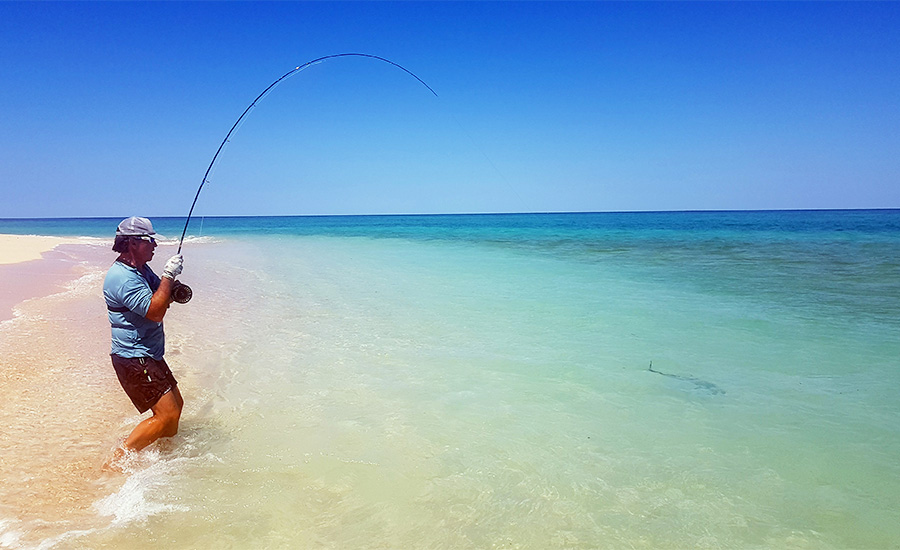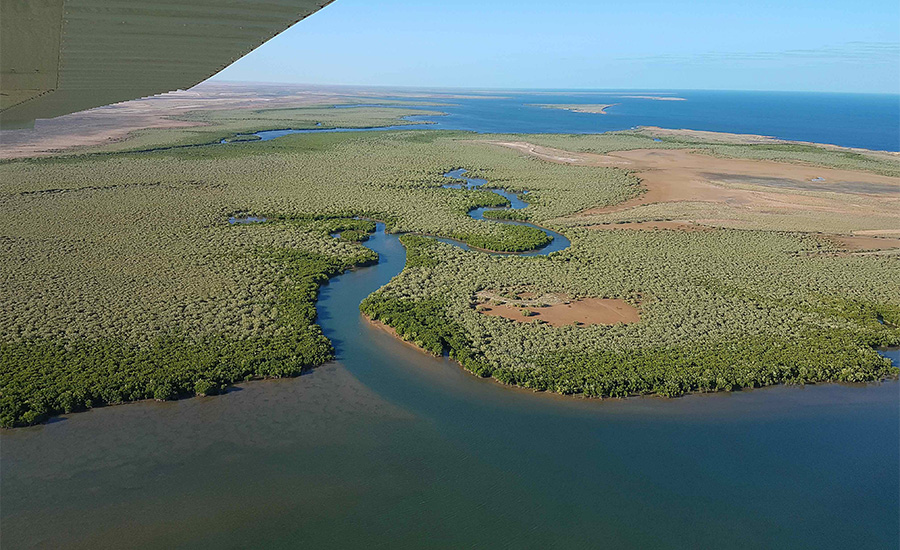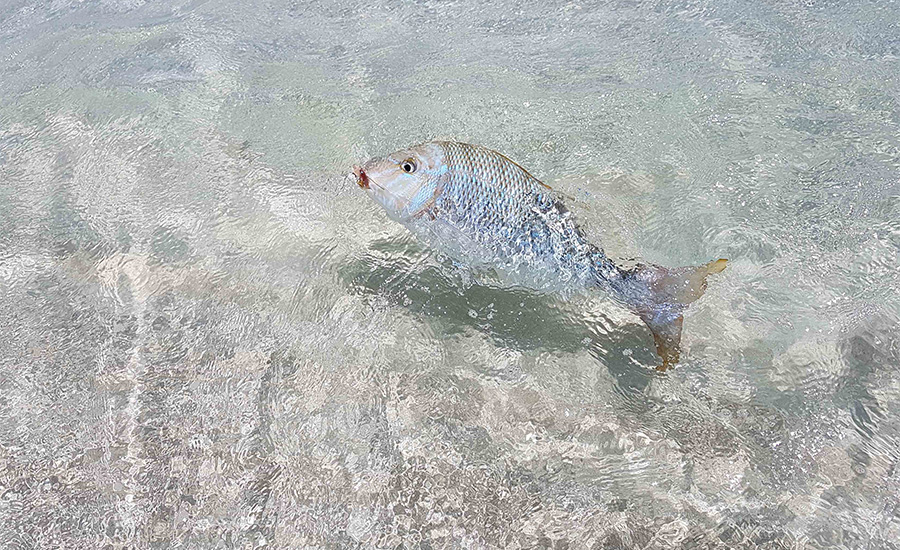Despite being born in an Alpine country I was infected with the saltwater fly fishing virus about two decades ago.
I have been travelling to numerous destinations around the globe since, always in search of the irresistible turquoise colour of pristine flats and the incredible power of their silvery fighters. Within the past two years I visited Australia four times exploring its best saltwater fishing spots. That wasn’t easy as the country is huge and it takes some time to get from one place to another. I also like to explore the underwater world be it by snorkelling or scuba diving. And I like animals in general. So the perfect place Down Under ideally had to offer all of this.
Australia is far away from Europe and it makes no sense to fish there for a week. A minimum stay of three to four weeks is a must as otherwise the long journey wouldn’t be worthwhile. My idea was to combine fly fishing with other activities as staying in fishing lodges and fishing with guides for several weeks makes it a very expensive trip. Fishing-wise Australia is blessed with a large number of excellent game fish. Many of them were completely unknown to me but turned out to be fantastic targets for fly fishers like King Fish, Kahawei, Cobia, Threadfin Salmon, Queenfish and first of all the most thought after game fish in Australia – the Barramundi. Besides that, Australia’s reefs offer some of the best offshore fishing in the world.
For the fly fisher, there are mainly three saltwater destinations worth considering: The Queensland Coast with its hot spots Hervey Bay (Fraser Island), Mackay and Hinchinbrook Island and the WA coast with Exmouth, Coral Bay and Shark Bay. Cape York and the Darwin region is the third one but as I also like to enjoy other kinds of water sports like diving and surfing, Cape York is a little dangerous if you go for a swim because of the large saltwater crocodiles and the highly toxic jellyfish that inhabit this area. After having spent a total of about six months in Australia I have found a spot that can easily compete with the best beaches on the Seychelles and the mangrove channels on the Cayos in the Caribbean. The place is called Exmouth and is situated about 750 miles north of Perth on the tip of a peninsula.
Heading North
You can take a plane from Perth to Exmouth but the campervan is probably the best way to travel if you like to explore the country and see a bit more than just a hotel room when coming home from fishing. It keeps you flexible. You do not necessarily need a 4×4 van but if you look for special access to fish near the gulf it can be helpful. You can reach Exmouth by car within a day if you leave very early. Heading north, the landscape changes several times and the colours range from green to brownish the further north you go. After taking the exit to the north of the peninsula only bushes remain and plain grass land. You will cross an area with thousands of huge termite hills until you finally reach the coastline of the gulf. After another 30-40 minutes you enter Exmouth. It is a small town where you can get everything you need. They have done a lot to provide a good infrastructure for travellers. Exmouth has a special flair. You feel that you are close to Cape Range. Emus are present even in the middle of the town.
After my arrival I went straight to nearby Bundegi beach where friends had successfully caught large queenfish the other day. The typically windy beach was dead calm. There were no baitfish around but huge humpback whales jumped right in front of us. At some spots they were as close as 600 yards from the shore. Every year thousands of them pass the beach on their way out of the gulf. Even if you are not a fisherman, seeing them jump, teaching their calves and playing around is worth a stay there. Diving with whale sharks is also possible if you are around in April or May.
Cape Range National Park
Bundegi beach is situated on the very north near the top end of the peninsula but still on the eastern side of the entrance to the gulf. Take the way to the lighthouse and after ten miles you reach the Indian Ocean. Cape Range National Park starts about 30 miles from Exmouth. After paying a moderate entrance fee you can stay in one of the twelve campsites in the Park if you wish. But you have to register online or directly at the Parks and Wildlife Center in Exmouth to reserve a spot. The campsites are very basic. They have clean toilets, but that’s all. No water, no electricity. If you like kangaroos, this is your spot. Thousands of them live here and they are quite used to people approaching them. They are very thankful for a drop of water. On hot days they might even choose to have a rest under the Jeeps as they provide the only shade available. But be careful in the evening or night they are so plentiful right next to the roads that they will for sure run into your car if you do not stop and pass them slowly. Be aware of the dingos. I like those funny wild dogs as it is so nice to see them play with everything. As long as you do not feed them you should face no problem. Just do not leave things unattended at beaches which are sometimes patrolled by dingos. They will certainly play with your things. It might look funny but they might grab your stuff and run away. You might also come across the Australian Bustard, a big bird that is quite curious.
Pristine Beaches
The beaches of Cape Range National Park are mind-blowing. Turquoise blue water and white flats just like the Seychelles. No palm trees behind you though but red lava rocks and sand dunes instead. On Sandy Bay flat the large Australian bonefish were first discovered in 2005. After publishing the spot a real hype followed and many big fish up to 30 – 35in were caught. The Australian Bonefish (round jaw bonefish) are a little bit slimmer than the Atlantic Bonefish and they feed in deeper water of 3-5 feet. So you usually catch them from a boat. As bonefish are a resident species it became more and more difficult to catch them. You cannot just go there and expect to catch one from the beach. Forget about that. It might happen, but you have to be very lucky. Not all the beaches are open for fishing as some of them are sanctuaries. Look for the ones where dry pebble creeks enter as the bottom structure there suits crabs which are permits’ favourite prey. If you are lucky you might even catch a Giant Trevally (GT) on the flats. Golden Trevallies, Spangled Emperors, Queenfish, cod and many other species can be caught there, too. And some flats are home to a lot of sharks.
Outside the reef lies one of the best offshore fishing areas in the world. As close as 1,5-2 miles offshore you can sight fish for sailfish targeting bait-balls. You can even fish for marlin in sight distance from the beach or try your luck for the various species of tuna. Most Australians just bottom fish there. Ningaloo Reef is much closer to shore than the Barrier Reef and at some spots like in Turquoise Bay it reaches right to the bank. You have fantastic snorkelling possibilities there. It is a healthy reef without any bleached corals as it regularly gets fresh cold water with southernly winds unlike the Barrier Reef which is not only far offshore but not that healthy any more. And there is another good thing. There are no box jellyfish or Irukandji to be aware of. It’s a paradise for both fishing and snorkeling/diving, provided there is no wind.
Words & Photography: Günter Feuerstein
First Published: The Wading List







